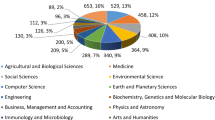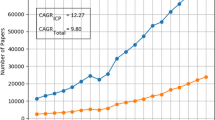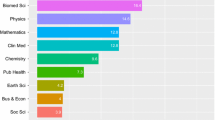Abstract
This study examines the research performance and international research collaborations (IRC) of ASEAN nations in the area of economics. Over the last 3 decades international collaborated papers have increased in the region, while locally-co-authored papers have declined. Singapore towered among ASEAN nations in research efficiency based on geographical area, population and GDP. Vietnam performed relatively better in research efficiency than research productivity (number of papers produced), while Indonesia performed poorly. Overall, internationally co-authored papers were cited twice as often as locally authored papers except that both The Philippines and Indonesia exhibited almost no difference in how their local and internationally co-authored papers were cited. The study also examined IRC from the perspective of social networks. Centrality had a strong correlation with research performance; however, vertex tie-strength (a result of repeat collaboration) showed maximum correlation with research performance. While Malaysia emerged as the nation with the highest betweenness centrality or ‘bridging’ power, the US emerged as the most favoured international partner of ASEAN nations. However, collaboration between ASEAN countries accounted for just 4 % of all international collaborations. Increased academic mobility and more joint scientific works are suggestions to consider to boost educational co-operation among the ASEAN nations.





Similar content being viewed by others
References
Abbasi, A., Altmann, J., & Hossain, L. (2011). Identifying the effects of co-authorship networks on the performance of scholars: A correlation and regression analysis of performance measures and social network analysis measures. Journal of Informetrics, 5(4), 594–607.
Arunachalam, S., & Garg, K. C. (1986). Science on the periphery: A scientometric analysis of science in the ASEAN countries. Journal of Information Science, 12(3), 105–117. doi:10.1177/016555158601200303.
ASEAN (2012a). ASEAN Charter http://www.asean.org/images/2012/publications/ASEAN-Charter.pdf. Accessed 10/10 2013.
ASEAN (2012b). ASEAN Declaration. http://www.asean.org/asean/about-asean. Accessed 19/10 2013.
Atan, H. B., & Havardwilliams, P. (1987). Library-education in the ASEAN countries. International Library Review, 19(2), 143–152. doi:10.1016/0020-7837(87)90026-4.
Barnett, A. H., Ault, R. W., & Kaserman, D. L. (1988). The rising incidence of co-authorship in economics: Further evidence. The review of Economics and statistics, 70(3), 539–543.
Beaver, D. B., & Rosen, R. (1978). Studies in scientific collaboration. Scientometrics, 1(1), 65–84.
Beaver, D. B., & Rosen, R. (1979). Studies in scientific collaboration Part III. Professionalization and the natural history of modern scientific co-authorship. Scientometrics, 1(3), 231–245.
Bhandari, M., Einhorn, T. A., Swiontkowski, M. F., & Heckman, J. D. (2003). Who did what?:(Mis) perceptions about authors’ contributions to scientific articles based on order of authorship. The Journal of Bone and Joint Surgery, 85(8), 1605.
Choi, S. (2012). Core-periphery, new clusters, or rising stars? International scientific collaboration among ‘advanced’ countries in the era of globalization. Scientometrics, 90(1), 25–41. doi:10.1007/s11192-011-0509-4.
Glänzel, W. (2001). National characteristics in international scientific co-authorship relations. Scientometrics, 51(1), 69–115.
Hanneman, R. A., & Riddle, M. (2005). Introduction to social network methods. University of California Riverside.
Hassan, S. U., Haddawy, P., Kuinkel, P., Degelsegger, A., & Blasy, C. (2012). A bibliometric study of research activity in ASEAN related to the EU in FP7 priority areas. Scientometrics, 91(3), 1035–1051. doi:10.1007/s11192-012-0665-1.
Heck, J. L., & Zaleski, P. A. (1991). Trends in economic-journal literature: 1969–1989. Atlantic Economic Journal, 19(4), 27–32.
Hollis, A. (2001). Co-authorship and the output of academic economists. Labour Economics, 8(4), 503–530.
Kato, M., & Ando, A. (2013). The relationship between research performance and international collaboration in chemistry. Scientometrics, 97(3), 535–553. doi:10.1007/s11192-013-1011-y.
Katz, J. S. (1994). Geographical proximity and scientific collaboration. Scientometrics, 31(1), 31–43.
Kliegl, R., & Bates, D. (2011). International collaboration in psychology is on the rise. Scientometrics, 87(1), 149–158. doi:10.1007/s11192-010-0299-0.
Kumar, S. (2011). Analyzing social media networks with NodeXL: Insights from a connected world. Information Research-an International Electronic Journal, 16(2).
Kumar, S., & Jan, J. M. (2013). Mapping research collaborations in the business and management field in Malaysia, 1980–2010. Scientometrics, 97(3), 491–517. doi:10.1007/s11192-013-0994-8.
Kumar, S., & Jan, J. M. (2014). Research collaboration networks of two OIC nations: Comparative study between Turkey and Malaysia in the field of ‘Energy Fuels’, 2009–2011. Scientometrics, 98(1), 387–414. doi:10.1007/s11192-013-1059-8.
Leydesdorff, L., Park, H. W., & Wagner, C. (2013). International Co-authorship Relations in the Social Science Citation Index: Is Internationalization Leading the Network? arXiv preprint arXiv:1305.4242.
Leydesdorff, L., & Wagner, C. S. (2008). International collaboration in science and the formation of a core group. Journal of Informetrics, 2(4), 317–325. doi:10.1016/j.joi.2008.07.003.
Luukkonen, T., Persson, O., & Sivertsen, G. (1992). Understanding patterns of international scientific collaboration. Science, Technology and Human Values, 17(1), 101–126.
Narin, F. (1991). Globalization of research, scholarly information, and patents–ten year trends. The Serials Librarian, 21(2–3), 33–44.
Narin, F., Stevens, K., & Whitlow, E. S. (1991). Scientific co-operation in Europe and the citation of multinationally authored papers. Scientometrics, 21(3), 313–323.
Newman, M. E. J. (2001). The structure of scientific collaboration networks. Proceedings of the National Academy of Sciences of the United States of America, 98(2), 404–409.
Nguyen, T. V., & Pham, L. T. (2011). Scientific output and its relationship to knowledge economy: An analysis of ASEAN countries. Scientometrics, 89(1), 107–117. doi:10.1007/s11192-011-0446-2.
Page, L., Brin, S., Motwani, R., & Winograd, T. (1999). The PageRank citation ranking: Bringing order to the web.
Piette, M. J., & Ross, K. L. (1992). An analysis of the determinants of co-authorship in economics. Journal of Economic Education, 23, 277–283.
Rodriguez, V., & Soeparwata, A. (2012). ASEAN benchmarking in terms of science, technology, and innovation from 1999 to 2009. Scientometrics, 92(3), 549–573. doi:10.1007/s11192-011-0603-7.
Rousseau, B., & Rousseau, R. (2000). LOTKA: A program to fit a power law distribution to observed frequency data. Cybermetrics: International Journal of Scientometrics, Informetrics and Bibliometrics, 4. Available at: www.cindoc.csic.es/cybermetrics/articles/v4i1p4.html.
Schmoch, U., & Schubert, T. (2008). Are international co-publications an indicator for quality of scientific research? Scientometrics, 74(3), 361–377.
Smith, D. C. (1988). Academic publishing in ASEAN–Gopinathan, S. [Book Review]. Scholarly Publishing, 19(3), 179–181.
Smith, M. A., Shneiderman, B., Milic-Frayling, N., Mendes Rodrigues, E., Barash, V., Dunne, C., et al. (2009) Analyzing (social media) networks with NodeXL. In Proceedings of the fourth international conference on communities and technologies (pp. 255–264). ACM.
Sombatsompop, N., Markpin, T., Ratchatahirun, P., Yochai, W., Ittiritmeechai, S., Premkamolnetr, N., et al. (2011). Research productivity and impact of ASEAN countries and universities in the field of energy and fuel. Malaysian Journal of Library & Information Science, 16(1), 35–46.
Sutter, M., & Kocher, M. (2004). Patterns of co-authorship among economics departments in the USA. Applied Economics, 36(4), 327–333.
Teodorescu, D., & Andrei, T. (2011). The growth of international collaboration in East European scholarly communities: A bibliometric analysis of journal articles published between 1989 and 2009. Scientometrics, 89(2), 711–722. doi:10.1007/s11192-011-0466-y.
Vinluan, L. R. (2012). Research productivity in education and psychology in the Philippines and comparison with ASEAN countries. Scientometrics, 91(1), 277–294. doi:10.1007/s11192-011-0496-5.
Wagner, C. S. (2005). Six case studies of international collaboration in science. Scientometrics, 62(1), 3–26. doi:10.1007/s11192-005-0001-0.
Wagner, C. S., & Leydesdorff, L. (2005). Network structure, self-organization, and the growth of international collaboration in science. Research Policy, 34(10), 1608–1618. doi:10.1016/j.respol.2005.08.002.
Wang, X. W., Xu, S. M., Wang, Z., Peng, L., & Wang, C. L. (2013). International scientific collaboration of China: Collaborating countries, institutions and individuals. Scientometrics, 95(3), 885–894. doi:10.1007/s11192-012-0877-4.
Wasserman, S., & Faust, K. (1994). social network analysis, methods and applications (First edition ed., Structural analysis in the social sciences). Cambridge University Press.
Watts, D. J., & Strogatz, S. H. (1998). Collective dynamics of ‘small-world’ networks. Nature, 393(6684), 440–442.
Zelnio, R. (2012). Identifying the global core-periphery structure of science. Scientometrics, 91(2), 601–615. doi:10.1007/s11192-011-0598-0.
Zheng, J., Zhao, Z. Y., Zhang, X., Chen, D. Z., Huang, M. H., Lei, X. P., et al. (2012). International scientific and technological collaboration of China from 2004 to 2008: A perspective from paper and patent analysis. Scientometrics, 91(1), 65–80. doi:10.1007/s11192-011-0529-0.
Acknowledgments
Authors thank the reviewers for their valuable comments on an earlier version of this paper. The study is supported by University of Malaya grant UM.C/625/1/HIR/MOHE/SC/13/3.
Author information
Authors and Affiliations
Corresponding author
Rights and permissions
About this article
Cite this article
Kumar, S., Rohani, V.A. & Ratnavelu, K. International research collaborations of ASEAN Nations in economics, 1979–2010. Scientometrics 101, 847–867 (2014). https://doi.org/10.1007/s11192-014-1363-y
Received:
Published:
Issue Date:
DOI: https://doi.org/10.1007/s11192-014-1363-y




